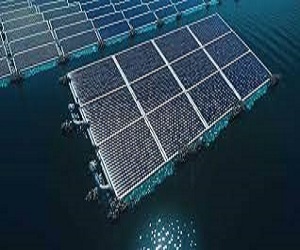India floating photovoltaics market is projected to witness a CAGR of 12.40% during the forecast period FY2025- FY2032, growing from USD 201.05 million in FY2024 to USD 512.19 million in FY2032. The market has experienced significant growth in recent years and is expected to maintain a strong pace of expansion in the forecast period.
In developing countries, floating photovoltaic technology is gaining attraction. Floating photovoltaics (FPV) is becoming one of the fastest adopted technologies among various applications of solar panels which has seen an expeditious transition in the developing country. Furthermore, India is adopting large-scale FPV projects in the southern region which showcase that the technology is swiftly reaching scale, and its market is becoming highly competitive. Currently, floating photovoltaic systems are seen as the third pillar of solar energy resources in the country.
In addition, floating photovoltaics plants act as a layering system to the water surface and significantly reduce annual water loss through evaporation which saves water for different applications. The integration of FPV into the multipurpose reservoirs and dams will increase the grid stability of the hydropower plants. Hence, the above-mentioned factors are likely to foster the floating photovoltaics market size in the forecast years.
For instance, in December 2022, Gensol Engineering company developed 30-MW of floating solar projects at three thermal power plants in Jharkhand and West Bengal.
Exploring Solar Panels Applications in Water Bodies
India is looking for new ways for power production through renewable energy sources along with maintaining the sustainability of the environment. The geographical condition of India is good with sun radiation levels which are suitable for power generation through solar photovoltaic systems. Manufacturers of solar panels are delved in exploring the new applications of panels in the market.
Even utility providers are exploring new applications of solar panels such as floating panels on the water bodies which would help to boost the production of renewable energy in the country. The use of floating photovoltaics on common water bodies such as ponds, lakes, dams, and canals, water treatment plants, and reservoirs contributes to an increase in the generation of renewable energy in the country. Floating photovoltaics have gained global attention in harnessing existing water surfaces for generating solar power, boosting the demand for solar panels for floating photovoltaics applications.
In addition, the natural cooling power of water helps to maintain the temperature in floating solar panels compared to the land-based installations. The cooling effect of water on floating photovoltaics plants boosts the efficiency of panels by 11% which propels the demand for solar panels in the floating photovoltaics application.
For instance, in 2023, the National Thermal Power Corporation installed a 92-MW floating solar power project at Kayamkulam in Kerala. The project is the second-biggest floating solar power project of National Thermal Power Corporation (NTPC).
Adoption of Combined Renewable Energy Sources to Fuel Market Growth
Utilizing renewable energy sources in combination provides a more reliable and balanced energy source. Combination of floating photovoltaics with other renewable energy sources offers several benefits which enhance the overall efficiency, reliability, sustainability of renewable energy systems, and provide stable energy supply to the grid.
Renewable energy generated by wind and solar power is reliant on the weather and time. However, the erratic demand for renewable energy in the country is occasional, which is sometimes not fulfilled by hydropower. Therefore, integrating floating photovoltaics (FPV) technology with hydropower facilities will increase the production of renewable energy from hydroelectric plants and make plants more consistent and manageable.
The power generation from floating photovoltaics plants would provide a more consistent and reliable energy supply which would reduce the need for backup from fossil fuel sources. Apart from the standalone FPV systems, hybridizing the FPV system with the hydroelectric power plants will assist in fostering the power generation in the forecast years.
Therefore, the integration of floating photovoltaics with other renewables has several benefits which boosts the overall adoption of renewable energy technologies and provides economies of scale to power plants. The adoption of combined renewable energy sources will expedite the transition to clean energy and supports country efforts to reduce greenhouse gas emissions and combat climate change.
For instance, The Omkareshwar Reservoir has a capacity of 600 MW, which is currently the largest in the world and the biggest in India. The aggregated capacity of 600 MW comprises six units of 100 MW each of grid-connected floating solar photovoltaic plants.
Government Incentives and Policies to Elevate the Market Size
Indian government is promoting the deployment of floating photovoltaics to boost the adoption of renewable energy systems. The government or higher authorities are planning to undertake various programs and legislative actions to develop floating photovoltaics (FPV) systems in the country. The initiative plan involves low-interest loans, tax breaks or reductions, and capital subsidies for project developers in the country. In FY2025, the Government of India (GOI) started several monetary incentives and subsidies for deploying floating photovoltaics (FPV) systems on man-made water bodies.
Even some states such as Maharashtra, Kerala, Tamil Nadu, and Andhra Pradesh have identified water bodies suitable for floating photovoltaics development. Several Southern states of India have introduced their own policies and incentive plans to promote floating photovoltaic installations in the region. The motive behind formulating the financial policies is to raise the floating photovoltaics market size and reduce the upfront investment costs of FPV projects.
For instance, National Solar Mission (NSM) commission decided to launch and promote solar energy in India and set ambitious targets for solar power capacity. While the initial focus was on land-based solar installations, the mission’s objectives have expanded to include FPV systems in India.
Dominance of Stationary Floating Solar Panels
The stationary floating solar panels have a high adoption rate which makes the segment dominate the market. Stationary floating solar panel products have fewer points of failure, which reduces maintenance and operation costs over the lifetime. The stationary floating photovoltaic products are cost-effective as the system does not need regular in-depth inspection. Moreover, governments and regulatory bodies continuously encourage the adoption of renewable energy technologies, including floating photovoltaics. In most countries, stationary floating solar panels have facilitated policy support, thereby making the product an economically feasible option for developers and investors. The several beneficial aspects of stationary floating solar panels sustain their dominance within the floating photovoltaics market.
Southern Region to Lead the Floating Photovoltaics Market Share in India
India floating photovoltaics market is expected to be dominated by the southern region in the forecast period. South India has a mix of geographical, environmental, and socio-economic factors which make the region appropriate for the deployment of FPV systems. The region includes several water bodies consisting of major reservoirs, lakes, and irrigation ponds, possibly ideal for installing floating solar panels. States such as Tamil Nadu, Karnataka, Kerala, Andhra Pradesh, and Telangana in South India have vast resources for drinking water, irrigation, and resources committed for generating hydroelectric power which creates the opportunity for the floating photovoltaics market.
In fact, Southern states of India have ambitious renewable energy goals and state policy to reduce state greenhouse gas emissions and have cleaner energy, boosting the floating photovoltaic markets in the country.
For instance, according to the report of India’s Central Electricity Authority (CEA), the annual power generated through RES over the period of FY2018 to FY2019 is 22.28-GW, from which the power production from the southern region of India constitutes about 9.78-GW.
Future Market Scenario (FY2025 – FY2032F)
1. Ongoing innovations and advancements in floating photovoltaics technology will improve floating platforms, buoyancy systems, and panel efficiency, which will enhance the feasibility and cost-effectiveness of these systems.
2. As environmental concerns push for more sustainable technological solutions, renewable energy sources will gain significance.
3. Features such as solar tracking and hydraulic pumps of floating photovoltaic systems will boost the demand for solar-tracking floating solar panels in the forecast years.
4. Rise in government supportive policies and financial incentives for renewable energy projects will boosts the floating photovoltaics market size in developing countries.
Report Scope
“India Floating Photovoltaics Market Assessment, Opportunities and Forecast, FY2018-FY2032F”, is a comprehensive report by Markets and Data, providing in-depth analysis and qualitative and quantitative assessment of the current state of India floating photovoltaics market, industry dynamics, and challenges. The report includes market size, segmental shares, growth trends, opportunities, and forecast between FY2025 and FY2032. Additionally, the report profiles the leading players in the industry, mentioning their respective market share, business models, competitive intelligence, etc.
Click Here:https://www.marketsandata.com/industry-reports/india-floating-photovoltaics-market
About Us:
Markets and Data provides a comprehensive/ panoramic understanding of markets at global, regional, and country levels. Examine changing consumer preferences, emerging challenges, underlying trends, and growth prospects to accelerate your business strategies.
Contact
Mr. Vivek Gupta
5741 Cleveland street,
Suite 120, VA beach, VA, USA 23462
Tel: +1 (757) 343-3258
Email: [email protected]
Website: https://www.marketsandata.com



